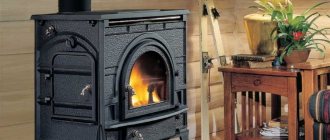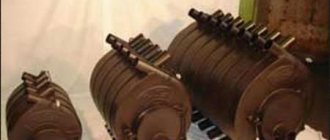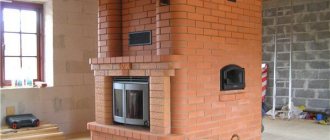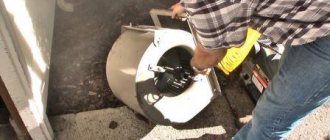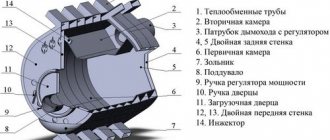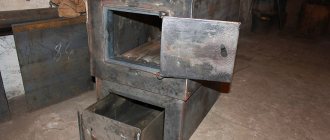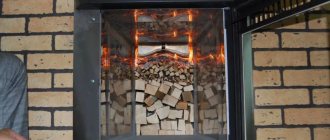DIY oven
What else will you need besides a metal barrel?
- Sheets of iron 4-5 mm thick.
- Pipe with a diameter of 100 mm.
- A grate is better prepared, although you can make it yourself, for example, from a corner and wire.
- Asbestos cord.
Barrel construction
Now the sequence of assembly work:
The lid of the barrel is cut out with an allowance of 40-50 mm. A hole is made in the center of it, slightly larger than the diameter of the pipe 100 mm. A rectangular hole is cut out at the bottom of the barrel for the firebox. Fuel will be loaded through it. A smaller rectangular hole is made just below for the blower. From the inside of the barrel, between the firebox and the ash pit, wire guides are welded onto which the grate will be laid. A hole for the chimney is cut in the upper part on the side. A pipe with a diameter of 100 mm and a length of 20-40 cm is immediately welded to it. Now a pancake with a diameter slightly less than the diameter of the barrel is cut out of a metal sheet. A hole is made in the center of the pancake and a pipe with a diameter of 100 mm is welded to it. The length of the pipe should be 20-50 cm greater than the height of the barrel. Rectangles 50-80 mm wide are cut out of the same sheet, but their length should be equal to the distance from the edge of the pancake to the edge of the through hole in the center. These pieces are evenly welded in a circle with an edge on the back side of the welded pipe. This node is called a press. With its help, the fuel will be pressed down so as not to create a large space for the combustion zone. Now we need to carry out partial assembly. That is, a grate is installed and a press is lowered from above. A lid is placed on it so that the press pipe fits into the hole in the lid. Now the lid is welded to the stove body around the entire perimeter
Here it is important to weld the seam very tightly. An asbestos cord must be placed in the gap between the protruding pipe and the hole in the lid; it will become a barrier to smoke and carbon monoxide. The door is hung on the opening of the firebox. The gate is installed on the blower.
Everything is ready, all that remains is to install the stove at its destination and attach the chimney to it
Under such a unit, a strong and fire-resistant base must be poured, this is important
Fuel loading
Now to the question, how to add fuel? For this you will definitely need an assistant. He will lift the press by the protruding pipe. You need to lift it as high as possible to completely open the combustion chamber. The fuel is packed tightly with minimal space between its parts. The less air inside the firebox, the longer the pyrolysis process takes.
Not everyone probably understood why the pipe that was welded to the press was needed. This is a special channel through which fresh air will be supplied to the fuel combustion zone. And the ribs welded at the bottom will create the necessary space for air to penetrate inside, plus they add additional weight to the press.
This is one of the models of long-burning stoves that you can make with your own hands from a two-hundred-liter metal barrel. Let's face it, the option is not the most difficult, but not the most beautiful either. No one will install a barrel in a living space, so such stoves are most often installed in utility rooms for office purposes. For example, in garages, workshops, greenhouses, and so on. Although some summer residents install them inside the main building, enriching the structure with additional elements. For example, you can install a decorative screen in front of the stove, or line it with brick. Anyone who wants to will find options to make the stove beautiful.
Fuel from water! - the cheapest…
Inventors of all stripes, from home craftsmen to academic consolidations, are trying to create something new. The priority is energy conservation and savings, new boilers and new, cheapest types of fuel.
The idea of creating fuel for the home from water, or with an admixture of water to make it cheaper, is not new. She still occupies a leading position among home inventors.
Is it possible to literally heat your house with water?, what were the results?, - more...
What's the idea
It is known that water consists of hydrogen and oxygen, H2O. Hydrogen itself (H2) burns, releasing energy 3 times more than ordinary natural gas. Oxygen (O2) is an oxidizing agent during combustion, a very active substance, it reacts with the same hydrogen, carbon (C) forming water and carbon dioxide CO2 or carbon dioxide CO gases with a large release of heat.
If you somehow split water into its components, you can get the most needed fuel cells.
The question arises: what will happen, for example, if water vapor is supplied to the plasma, mixed with burning wood or coal...
Amazing experiments more...
Experiments with eternal logs
An everlasting log is a small metal tank with small holes to allow water vapor to escape. This container is filled with water, the neck is screwed on, and placed on the bottom of the oven. The container heats up to a high temperature, water vapor comes out of it, going directly onto the burning coals.
As a result, according to the experimenters, black soot disappears in the smoke. Those. supposedly the carbon particles normally carried away into the pipe now all react with oxygen. The flame becomes saturated with long tongues, etc.
But it’s true that measurements of the actual heat received were not carried out, it is impossible to measure it at home, but all the signs of high energy output are present...
Adding water to regular fuel
By analogy, another experiment from people who call themselves “home inventors.”
What happens if you add water to diesel fuel? It turns out that the mixture is burning! There is also less soot, some roughness of combustion occurs, and a crackling sound is heard.
Add a little diesel fuel to a bottle of water, mix it well, let it sit for about five minutes, then dip a piece of paper into the top of the mixture, set it on fire, and it burns.
Another experiment. We mix diesel fuel with water in some proportions, pour it into the diesel engine of the tractor, start the unit, the tractor works. those. rumbles, standing still...
And you can come up with many more similar experiments with adding water to any fuel (flammable substance) - gasoline, gas, oil, diesel fuel. And if done carefully, it is likely to get burned...
Similar videos from “inventors” can be easily found on the Internet. And we can conclude that water can be used to heat a house, for example...
What can be questioned
In such experiments, the main thing is not agreed upon - the amount of heat received, energy released and work done.
This applies to both eternal logs and burning diesel fuel with water. But it is not known whether the “tractor on water” will be able to move, let alone work for months and years.
After all, everyone knows that water is used to extinguish, not to light... Because water has a high heat capacity, it cools the burning object, enveloping it, preventing oxygen from the air from accessing the carbon (usually) in the fuel. Therefore, putting out a fire with water from a bottle is no problem.
Why can't you drown with water?
The following is known. To decompose water into oxygen and hydrogen, you need to spend more energy than will be released during their reverse reaction. The ratio is something like this:
- for water splitting - 100% energy;
- When the components are burned, only 75% of the energy will be released.
That’s why nothing rides on water, doesn’t fly, doesn’t spin...
A car that runs on clean water has long been created. The splitting of water is achieved through electrolysis - H2 is released at one electrode, and O2 at the other. They are then burned in an internal combustion engine. But such a car turned out to be the least economical of all existing ones...
Pure deception
All experiments with adding water to ordinary fuel (to “burn water”) are pure deception. No energy is added. On the contrary, the benefit decreases, since most of the energy is spent on evaporation of water.
When heated by normal combustion, water does not enter into any reactions; it simply evaporates. And for this process it is necessary to select the lion's share of the heat, which could be used usefully.
For example, when burning dry wood with a humidity of no more than 20%, about 3.9 kW will be released per kilogram of fuel. When burning wet wood, 50% humidity - only up to 2.2 kW per kilogram.
What's Really Happening
- When a piece of paper dipped in a solar-water mixture burns, a cracking sound is heard - the evaporation of water. Before this, a drop of diesel fuel is mixed in a bottle of water, shaken, but then it is allowed to settle, and the diesel fuel again collects at the top of the bottle. Diesel fuel, oil, gasoline do not mix with water, do not create homogeneous mixtures, they are lighter and gradually accumulate on the surface.
- A tractor running on a water-solar mixture will not do anything - the diesel energy will not be enough for work. All you have to do is chatter while standing still. And the engine will quickly fail...
- The eternal log greatly cools the oven, taking energy to evaporate water. It's like heating with wet wood.
- The following schematic drawing of a burner with water supply to the natural gas combustion zone is a common deception.
We always drown with water
Water vapor is always present in the air. In residential premises, the average air humidity is 50%, in rainy weather outside the humidity is 90%. So water is already present during the combustion of any fuel; it is found in large quantities directly on the hot surface of the substance that reacts with oxygen from the air, whether we like it or not. It turns out that there is no need to carry out such experiments, water is always present in the flame anyway...
Construction of gas generator type furnaces
Gas-generating water heating furnaces do not contain a firebox, like conventional models. The design of all pyrolysis furnaces is very complicated. A wood-burning gas generator stove consists of a pre-gasification chamber - firewood is directly placed into it, and a combustion chamber - where the fuel is processed into heat. Gases from the gasification chamber enter the combustion chamber through the nozzle due to the action of the fan. (See also: Long-burning heating stove)
Please consider the following factors when assembling and using:
- The humidity of the firewood used should not exceed 20%. This is a fairly low indicator, which characterizes the firewood as very dry. During normal storage, firewood can dry to a level of at least 30-40%, and to achieve the above figure, you will need to use a heat gun or another option for drying firewood.
The connection between the chimney and the outlet damper should be very easy to disassemble. The fact is that with increased humidity of the wood, condensation will form, containing tree resin. This same condensate, passing through the chimney, will be able to clog it - in this case, resin-like clots are formed that cannot be soaked with water and are not subject to combustion. They are quite difficult to remove from the chimney.
Operating principle
It’s not for nothing that they say that everything new is well forgotten old. The ancient Bible echoes this proverb: “What has been is what will be; and what has been done will be done, and there is nothing new under the sun” (Ecclesiastes 1:9). Indeed, all physical and chemical laws were invented and put into practice long before we were born, so a person can only use them for his own purposes.
Thus, few people know that to enhance combustion in steam locomotives and other similar units actively used in past centuries, water was used as a combustion catalyst. Remembering this feature of a commonly available liquid, some modern Kulibins came up with a simple design for a furnace, where water as fuel helps to increase the heat transfer efficiency by tens of percent.
Thanks to a water stove, you can provide unprecedented warmth in your home.
The fact is that when water vapor is heated to temperatures above 600 degrees, a flammable mixture of hydrogen and carbon monoxide is formed . In combination with oxygen, it burns remarkably well and contributes to an even greater rise in temperature.
This is why severe fires and fires with high temperatures cannot be extinguished with water or snow. On the contrary, this method promotes even greater flare-up. This is interesting: a version of a waste oil boiler with a water circuit.
However, if you take control of this feature of the most common liquid, you can achieve an amazing effect that helps improve the combustion process.
Here are the main advantages of this method:
- More complete combustion of fuel and less combustion waste.
- The absence of black smoke means less soot – a cleaner chimney.
- Higher combustion temperature, greater heat transfer.
- Excellent combustion of raw wood, no smoke.
- The combustion time of the same amount of fuel almost doubles.
In this video, learn more about the water stove:
It turns out that using a water-based stove design is much more effective than the conventional option.
The principle of gas generation. Scheme of operation of a long-burning furnace
The operation of gas generator furnaces is based on the principle of wood gasification - a fuel combustion mode in which pyrolysis gas is formed.
Gas generation is achieved by burning fuel in smoldering mode under conditions of oxygen deficiency. The efficiency of such a heating unit increases several times in comparison with classic combustion furnaces.
The combustion mode is regulated by supplying air to the firebox. Heat is transferred to the heated room through heat exchange surfaces.
Let us immediately clarify the terminology of the processes underlying the operation of such heating units. All manufacturers, without exception, call the furnaces they offer that operate in smoldering mode gas generators. From the point of view of the formation of pyrolysis gas in this combustion mode, this does not raise any objections. However, this, in fact, is where the matter ends.
The operating principle of a classic gas generator furnace is as follows. The pyrolysis gas formed as a result of wood smoldering (mainly carbon monoxide and methane), passing through a special nozzle, is mixed with air. Entering the combustion chamber, the gas-air mixture ignites in the presence of a catalyst and burns with high heat output. In this case, complete burnout of all heavy fractions and soot occurs, and the remaining flue gases have almost no impurities.
Air is forced into the combustion chamber. The flame has a pronounced white color - a sign of complete combustion with excess oxygen.
Nothing like this happens in advertised “gas generator” stoves for home heating. There is only one doubt that pyrolysis gas is formed in the combustion chamber. But it is not used, but leaves the stove through the chimney circulation. those. it simply “flies down the drain.”
The color of the flame in the firebox is red. and a coating of soot and tar quickly forms on the walls of the pipe, which indicates incomplete combustion of the fuel. It would be more correct to call such furnaces smoldering or slow burning furnaces.
In this regard, many of the manufacturers' advertising statements, such as ultra-high efficiency, are at least questionable.
Despite the obvious inconsistency of such furnaces with gas-generating classics, they are still not without certain advantages.
Furnaces with a water circuit - 3 varieties
To implement stove heating combined with the radiator system of a private house, 3 types of stoves with a water circuit are used:
- metal - steel and cast iron stoves with a built-in coil for heating the coolant;
- fireplace inserts with a heat exchanger - water jacket;
- heating and cooking stoves made of brick with a built-in boiler.
Note. Potbelly stoves for baths, equipped with a tank and a coil, are structurally similar to the listed units. It is theoretically possible to adapt a sauna stove for the needs of steam heating, but it is too troublesome and inconvenient from the point of view of operation.
Pipes filled with water pass over the flame and receive maximum heat.
This also includes an alternative option - steel wood-burning heaters, made by yourself. Such products deserve attention because they are not inferior to factory ones in terms of reliability and heat transfer, but they are much cheaper. The appearance of a potbelly stove does not always play an important role.
We propose to consider the stoves of each group separately, focusing on the disadvantages and advantages that are important for the homeowner.
Disadvantages of metal potbelly stoves
In factory-made wood stoves, the coolant is heated in three ways:
- A water-tube heat exchanger is installed in the upper zone of the firebox or near the flue gas outlet.
- One of the walls of the combustion chamber (top or side) is in contact with a water layer, reminiscent of the jacket of a solid fuel boiler.
- Several coolant pipes go around the semicircular walls of the firebox. The ends are welded from below and above into common collectors, as shown in the drawing.
Modification of the convective heater "Breneran" (analogue of the well-known "Buleryan") with a water-tube heat exchanger
Reference. An example of a product with a partial water jacket is the Termofor Hydraulic house heating stove, with side pipes - converted Breneran-Aquaten convection heaters.
Manufacturers often supply stoves with an additional heater - a heating element with a power of 1...15 kW. The goal is to maintain the temperature of the coolant and air in a private house after a portion of solid fuel burns out. Some models are equipped with a hob with 1-2 burners.
The real advantage of metal heating units is the low cost of the product and speed of installation compared to laying a brick oven. Example: the price of a 3.5 kW Breneran-Aquaten heater is approximately 270 USD. e. (without chimney). When installing a potbelly stove with your own hands, you will spend another 50-100 USD. e. on materials used for installation and strapping.
The Hydraulic series of heaters from the famous Termofor brand are equipped with a water jacket and pipes surrounding the firebox
Comment. The cost of the chimney pipe required for any stove is not taken into account. The price greatly depends on the lifting height, channel design and laying pattern.
Now let's look at the disadvantages:
- no matter what manufacturers and sellers claim, the maximum efficiency of air-water stoves using wood and coal is 60%;
- the unit heats up and cools down equally quickly;
- the heat exchanger is usually enough to heat 2-3 small rooms (1 radiator in each);
- The water circuit needs a circulation system.
It is not easy to maintain cleanliness and beauty around the stove, which serves as the main source of heat in the house
. Let us clarify the last point. If the flow of water through the coil stops, the element will overheat. First, the coolant will boil, then evaporate and break the nearest weak connection. Later, the heat exchanger will burn out and finally fail.
To be fair, let us mention the issue of aesthetics. By constantly using a potbelly stove to heat your home, you will not get the beautiful picture that manufacturers like to show in the photo. The stove will quickly become dirty, wood and coal dust will appear in the room, and the smell of smoke will appear.
Fireplace inserts - pros and cons
A rectangular stove with a water circuit, made in the form of a fireplace, is structurally much closer to a TT boiler. The side walls of the fuel chamber are washed with coolant, the front and top parts heat the air in the room. The bottom receives little heat, so it is not taken into account.
Positive aspects of fireplace inserts equipped with a water heat exchange jacket:
- fuel combustion efficiency – up to 70%;
- reasonable cost (compared to brick buildings);
- simple and quick installation;
- A fireplace stove equipped with a transparent door will fit perfectly into the interior of a living room.
Reference. The Termofor Aquarius fireplace water insert with a heat output of 12 kW will cost 530 USD. e. It is difficult to estimate additional costs; their value depends on the method of decorating the fireplace. Budget option: place the heater on a solid base, connect it to the radiator network, and do the finishing yourself or put it off until later.
The boiler tank surrounds the combustion chamber on the sides and partially on top.
The disadvantages of metal fireboxes are similar to the disadvantages of furnaces:
- the fireplace heats up and cools down quickly and requires continuous circulation of the coolant;
- provides heat to a limited number of batteries;
- due to temperature changes, condensation forms on the internal walls and soot deposits are deposited;
- complete resemblance to a natural fireplace is achieved through design - decorative brickwork or plasterboard sheathing.
When using a fireplace insert as the main source of thermal energy, do not count on long-term combustion from 1 start. Example: the useful volume of the combustion chamber of the aforementioned Aquarius is only 62 liters, but it will not be possible to completely fill the firebox with firewood. You will have to add logs every 3-4 hours.
Over time, the walls of the firebox become covered with soot, and the panoramic glass becomes covered with soot.
Note. Most steel stoves suffer from a similar drawback - in intense combustion mode, you just have time to throw in some firewood.
Strengths and weaknesses of brick heaters
Heat exchangers are installed inside the stove in two ways - in the firebox or in the flue, along the path of the hot combustion products. Each option has its own nuances:
- the boiler in the combustion chamber quickly warms up under the influence of the flame, but forms condensation and soot on the walls;
- in the event of boiling and steam formation, the tank may rupture right in the firebox and destroy the brickwork;
- the heat exchanger inside the smoke circuits is much safer, but heats up more slowly because it receives less heat.
Reference. The coil placed in the flue must have twice the heat exchange area than a boiler in the firebox of comparable power.
Location of the water circuit inside the combustion chamber (left) and chimney channels (right)
The main disadvantage of any brick heater is the high cost of materials and masonry work. Suppose you decide to save money and build the stove yourself. This will require experience, time and technical capabilities - starting construction in the middle of a habitable house is not easy. The best option is to lay the foundation and furnace at the stage of wall construction.
Why are stone stoves with a built-in heat exchanger valued:
- service life is incomparably longer than any heat generator - at least 50 years;
- the ability to accumulate heat and heat adjacent rooms for a long time after extinguishing;
- maximum efficiency – 70…75%;
- in a heated stove, the soot that forms on the walls of the tank and in the chimney burns out well;
- some brick stoves - Dutch duct, Swedish, Kuznetsov's bell-type stove - can easily heat a two-story house.
Interesting fact. A water heater section can be added to any brick stove. Smart stove makers know how to change the layout and procedures to install a heat exchange water register.
Useful tips for craftsmen needed when installing a stove
A mandatory element for the safe use of a pyrolysis furnace is the foundation on which the unit is installed.
The foundation must have a high degree of reliability. The foundation for the stove is constructed from heat-resistant building materials. The design of the stove has a small mass, so the stove does not create much pressure on the base. During operation of the installation, a high temperature is created, which can cause damage to the foundation; in order to prevent the destructive effect of high temperature on the foundation, heat-resistant materials must be used in its construction. The material used is refractory brick, which is laid on a pre-prepared concrete base.
Read also our article Installation of a heating system for a private house: basic diagrams.
The concrete base for installing a long-burning furnace should be poured into a shallow foundation. In the process of preparing the foundation, its obligatory component is the reinforcing frame.
The chimney for the stove must be installed as a separate element of the heat generating installation. A metal pipe of the appropriate diameter can be used as a chimney. When installing the chimney, it can be secured by welding to the top cover of the stove.
When making a stove with a rectangular cross-section, the chimney can be connected to the installation only from the side.
When installing the chimney, remember that immediately after the stove body the chimney must run strictly vertically. When designing a chimney, a minimum number of bends and elbows should be used.
Since when using solid fuel a large amount of soot is formed, it is best to design the chimney as a collapsible one, since it will periodically have to be disassembled and cleaned of accumulated soot.
Once the stove has been designed and installed, it is recommended to install a reflector. With the help of this structural element, heat flows are redistributed, which contributes to uniform heating of the entire volume of the room. In addition, installing a reflector allows you to increase the degree of safety during operation of the heat generating plant.
The place intended for installation of the furnace must meet all fire safety requirements, since the furnace body, heated to a high temperature, is a potential source of fire if the operating rules of such equipment are violated.
(Visited 1,614 times, 1 visits today)
Vertical option
Diagram of the internal structure of a gas-generating furnace made of stone.
If you don’t have space, you can make a vertical version of the stove body. It is a little more complicated than the horizontal unit described above. The main body of this gas generator has dimensions of 700×510×1480 mm. This installation must be equipped with a grille made of steel sheet. It is installed in the gas generator housing at a distance of 30 cm from the bottom of the housing on legs made from scraps of steel pipe. The grille is connected by welding to a box installed inside the unit.
A deflector is welded to the side wall of the gas generator, holding the box with the grill and allowing air free passage to the burning fuel. All these parts are made of steel sheet (thickness 4-5 mm). As a chimney, a steel L-shaped pipe is welded into the gas generator housing (above the box at the side wall of the installation). On the same wall (in the lower part of the housing at the level of the grille) make a hole with a diameter of 10 centimeters to allow air to pass inside the installation.
At the level of the lower part of the chimney pipe (in the housing), drill a 6 cm hole. In this version of the gas generator, a fan mounted on the lower hole of the air duct is used to force air into the firebox. For normal use of the boiler and good thermoregulation of the installation, an automation system is installed on the side wall of the gas generator. Its actuator in the form of a chain is connected to the fan switch button.
If you want to use this boiler not only for heating, but also in conjunction with water heating, then you will have to make a heat exchanger yourself. It is made from sheet steel and consists of a casing larger in diameter than your furnace, placed on top of the body of your gas generator. This casing is carefully wrapped in thermal insulation using glass wool or other similar thermal insulation material.
To enter cold and output hot liquid into a water heating system, the inlet and outlet pipes are connected to the heat exchanger. Valves and other necessary equipment are installed according to a standard scheme for heating a home with water heating. The water boiler you assemble can operate not only on wood, but also on coal. If you have problems using metal, then the body of the gas generator can be assembled from bricks, but such an installation will have large dimensions.
Stove prices
The market is quite competitive and you can find a unit that suits your budget and your parameters. You can buy a stove either in an online store or in specialized outlets/shops in your city or region. Let's give an example of a couple of popular models.
Fire - Battery 7B anthracite
- Room volume, m³: 150
- Firebox volume, l: 45
- Dimensions, (HxWxD) mm: 760x370x680
- Oven weight, kg: 54
- Chimney diameter, mm: 120
- Heat exchanger tank volume, l: 1.3
- Price: 16-19 thousand rubles.
Stove - fireplace Angara Aqua
- Room area up to 90m²
- Total power, kW: 18
- Water circuit power, kW: 9
- Heat exchanger volume: 4 l
- Oven dimensions: HxWxD, mm: 1020x550x490
- Oven weight kg: 150
- Chimney diameter, mm: 150
- Chimney connection top, rear
- Price: 32-37 thousand rubles.
Solid fuel boilers. which also have a water circuit. A combined or solid fuel type boiler can heat a room up to 170 sq. m. Such boilers can operate both on wood and electricity. They are made mainly of strong steel. Stove-Fireplace with a water circuit (they also come with a stove and grill). Such thermal fireplaces do not have high efficiency compared to stoves, but they can also be connected to a heating system and heat several small rooms. Read more in the article about fireplaces with a water circuit.
In order not to make a mistake in your choice and purchase a truly reliable and convenient in all respects long-burning stove with a water circuit, you should study all kinds of information provided by trading companies or reviews
buyers. It is necessary to study the characteristics of the device in its entirety, that is, not only the technical parameters of the device are important, but also its dimensions, appearance, cost, and additional functions. Compare the parameters of your home and the features of its design with the capabilities of a particular model.
But if you are not confident in your abilities or want to save your time, then contact professionals; they will draw up a project for a reasonable fee and offer various options for implementing your idea.
Design and equipment of a long-burning furnace
Visually, long-burning stoves are very similar to ordinary traditional fireplaces. They just have a different configuration, hidden under the body. The design solution of such heaters consists of:
- firebox (combustion chamber) in which combustion occurs. The chamber has two parts - in one, firewood is burned, in the other, made in the shape of a dome, flue gases are stored.
- doors with glass to create maximum tightness of the firebox
- cases with decorative finishing
- regulators of combustion processes and air supply (primary, secondary)
- ash box and firewood (optional)
- chimney
The configuration described above is basic. Long-burning stoves are often supplemented with other devices that increase the heat transfer of the hearth. The most effective are such add-ons. options such as a water “hydro” circuit and a system for distributing hot air throughout the premises. In this case, the basic configuration is equipped with the following devices:
- pipes for connecting air distribution
- turbine
- convection casing
- water circuit, heat exchanger
- control system (sensors, regulators)
DIY gas generator assembly
- DIY gas generator (furnace) assembly
- Vertical option
- Materials and tools used
To heat a room in modern conditions, various types of heaters are used. These are mainly converters with various coolants (gas, water, electric current). But if you have a plot or dacha in an area where there is no possibility of gas heating, and heating your dacha with electricity is expensive, then you will have to install a conventional wood-burning stove. To reduce costs, it is desirable that it uses as little wood as possible and produces a large amount of heat.
A gas generator (also known as a pyrolysis) furnace is used in country houses, dachas, private houses, that is, where there is no central gas main and central heating.
More economical installations were used in the early and mid-20th century. They are called gas generator boilers (furnaces), have a high efficiency (up to 75%), and through a non-standard combustion method in such installations, fuel savings of up to 50% are possible.
You can make such a gas-generating furnace with your own hands from scrap materials if you have the skills to handle the tool. This device can be used in conjunction with water heating. Here is a diagram of the design of gas-generator heating installations, and recommendations for assembling them with your own hands are given.
A gas generator furnace (boiler) using wood as fuel consists of the following parts:
- fan (in vertical furnace models);
- gasification preliminary firebox (firewood is placed in it);
- the combustion chamber.
Gases from the furnace pass through the nozzle using fan pressure into the combustion chamber of the furnace, where the main heat release from the fuel occurs. Firewood must have a moisture content of at least 20%, that is, be very dry. If this condition is not met, then the tar condensate formed when burning wood will clog the chimney.
For long-term burning of fuel, such an amount of firewood is placed in the furnace (in the gasification furnace) so that it occupies 85-90% of its volume. The area heated by the installation ranges from 8 to 90 square meters. The time it takes to reach the desired room temperature directly depends on the design of your installation. You can also use the boiler both for simple heating of water (for bathing) and in conjunction with water heating.
Some design features of furnaces of this type
A typical wood burning stove with a water circuit consists of the following main parts:
- Directly to the oven;
- A cast iron or steel heat exchanger with a developed contact surface integrated into the combustion space;
- Heating radiators;
- Coolant flow lines, consisting of metal or plastic pipes, shut-off valves, a set of valves and splitters;
- Control and safety group equipped with temperature, pressure monitoring devices, as well as emergency valves;
- An expansion tank that compensates for the excess volume of water resulting from its heating and subsequent expansion.
- As an additional option, you should consider a circulation pump, which is a mandatory part of a system operating on the principle of forced circulation.
A metal or brick oven with a water circuit can be made according to the principle of natural or forced circulation. As a compromise option, a combined system based on the practical application of both principles should be considered.
System with natural coolant circulation
Natural or thermosiphon circulation is provided based on the principle of natural expansion of water when heated and its movement in the required direction, specified by slopes. A number of fundamental principles should be considered a prerequisite for the reliable functioning of such a system:
- The furnace heat exchanger should be located below the level of the radiators.
- The flow area of the main fittings pipes must be at least 57 mm, with the nominal calorific value of the furnace at the level of 15 - 17 kW.
- The system must be equipped with an expansion tank located at a height that ensures reliable circulation of the outgoing flow. As a rule, at least 215 cm from the level of the lower edge of the heat exchanger.
- The return flow line must be installed with strict observance of the slope level, guaranteeing free circulation of the cooled coolant along the way to the furnace heat exchanger.
The natural circulation system is absolutely energy independent, however, it requires a larger amount of coolant in the system. First of all, due to the large flow area of the highway.
System with forced circulation of coolant
Its operation does not require a sufficiently large cross-section of the pipeline, since the coolant is “pushed” under pressure through the operation of a vortex-type circulation pump. It is obvious that modern production also operates with other types of pumps. Reducing the volume of coolant due to a significant reduction in the cross-section of the lines leads to a significantly higher thermal efficiency of the system as a whole and fuel economy in particular. In addition, heating radiators equipped with Mayevsky taps allow you to quickly and effectively eliminate air “locks” by creating excess pressure. The fact of active circulation also determines the presence of an expansion tank of a significantly smaller volume compared to thermosiphon systems. The most significant disadvantage of such furnaces is the fact of direct dependence on uninterrupted power supply. An attempt to combat this disadvantage should be considered the emergence of combined systems.
Combined coolant circulation system
It is a thermosyphon type system equipped with a circulation pump. An additional option is a bypass loop equipped with a rotary tap. Under normal conditions, the pump operates; in the event of a lack of power supply, the inlet pipe with the pump is closed, and circulation is ensured through a bypass loop made of a large cross-section pipe. In essence, this is the same thermosiphon system, with all its inherent disadvantages, however, retrofitted with a pump. In this form, it is rational to see only a double-circuit stove for a bath, where the second circuit is used for hot water supply. Then a large volume of coolant can be used to meet the need for hot water.
https://youtube.com/watch?v=aB1duN9-N4c
The operating principle of this type of heating device
For most heating devices, the heating function is realized by heating the device itself, heating the surrounding air and subsequent heat transfer by its walls. This occurs as a result of rapid and intense combustion of fuel. This method is not very convenient for several reasons: “jumps” in the temperature in the room, incomplete combustion of fuel, resulting in the formation of a lot of soot and soot, the need to constantly add coal or firewood to the firebox and adjust the draft. In long-burning furnaces, everything happens somewhat differently.
Pyrolysis boilers are particularly economical: in addition to the principle of slow combustion of fuel, they also burn gases formed as a result of combustion. Thus, the efficiency of such a heating device increases significantly, reducing costs.
"Pros and cons"
Undoubtedly, the high efficiency (up to 85%!) and the small size of such units have earned them great popularity, especially where there are no other heating resources - natural gas, electricity. It is attractive to be able to load fuel once, after which you just need to adjust the draft in the firebox when the required room temperature is reached. It remains stable for a fairly long period of time - depending on the device model - and can reach 30 hours or more.
The variety of models allows you to organize both air and water heating of the house - in this case, a water circuit is connected to the stove. You can also connect a container for heating water for domestic needs to such a stove; you can even cook and heat food on it - in a word, this device turns out to be truly multifunctional.
A relative disadvantage of this device is its utilitarian appearance: such a stove is unlikely to decorate the interior, but this is not required of it. It can rightfully be called a “workhorse” among heating stoves.
The gases leaving the firebox into the chimney have a low temperature (compared to conventional stoves) - about 2000, which leads to the formation of condensation in the chimney. Such a stove cannot be connected to a curved, multi-pass pipe, since the draft in it is very low and combustion products will not be discharged outside.
The long-burning mode does not start working immediately - first, the temperature in the room should be brought to the required level, only after that the draft is reduced and the stove is switched to an economical mode. In this case, the temperature no longer increases, but is only maintained at a given level.
Types of fuel used in this type of furnace
Another advantage that a long-burning furnace has is the ability to use various types of fuel - solid, liquid and gaseous. True, each of them has its own device model - there is no universalism here. By choosing a model that runs on the most affordable and profitable type of fuel in the area, you can fully ensure efficient and economical heating of your private home, cottage, or industrial premises.
Long-burning stoves on the Russian market
A large assortment of stoves with long-burning options from the world's leading manufacturers is presented in all showrooms. In the showrooms, customers will find products of various sizes, designs, arrangement methods, and power. Models are presented with a hydraulic circuit and pipes for distributing hot air to adjacent rooms. We also sell individual components, heat-storing stones and materials, and services for creating individual projects for heating houses of any size.
How to make a gas generator oven yourself
Gas generators, also called pyrolysis boilers, are increasingly used in everyday life. They are used for heating residential and commercial premises, cooking, obtaining hot water, captivating with their high efficiency, environmental friendliness and ease of maintenance. However, industrial designs are expensive, so the optimal solution for a thrifty owner would be a gas generator stove, made with your own hands from scrap materials.
Functioning and design features
The main principle underlying the work is the gasification of solid organic fuel when it is burned under conditions of oxygen deficiency. During the process of decomposition (pyrolysis), solid organic matter in a gas generator furnace does not burn, but slowly smolders, forming a large amount of flammable gas, which mainly consists of methane and carbon monoxide. The resulting gas from the combustion chamber enters the afterburning compartment, in which it mixes with heated air and burns, releasing a lot of heat. Depending on the design features, the gas generator can heat the coolant jacket, release heat to the environment, or perform both of these tasks.
Such furnaces demonstrate high operating efficiency, several times higher in efficiency than traditional ones. Unlike classic solid fuel boilers, the owner of a pyrolysis boiler is able to flexibly control operating modes and change the heating temperature of the coolant. To do this, it is enough to increase or decrease the amount of air supplied to the combustion chamber of a gas-generating furnace. Combustible gas can be extracted from almost any solid organic fuel: firewood, coal, peat and even linoleum. But in everyday life, the first one and wood processing waste are most often used. The most common type of wood-burning gas generator is a pyrolysis furnace, from which gas is not removed, but is burned to produce thermal energy.
The main design feature is the presence of two combustion chambers. In one, the process of decomposition of organic fuel occurs, and in the other, the resulting gas is burned. Moreover, the afterburning chamber in the first case can be located differently: under the gasification compartment, above it, or on the side. The internal structure and circuit of a gas-generating wood-burning stove for domestic needs is simple, and any home craftsman can make it.
Classic pyrolysis equipment should include:
- The housing inside which the working elements of the furnace are mounted.
- Filling chamber (hopper) for storing firewood or wood waste.
- Afterburning section of the gas released by the furnace.
- Grate for holding solid fuel and coals.
- Doors for loading firewood and removing ash from the gas generator.
- A system of air dampers to control the supply of oxygen to the working area of the device.
What is needed for making
Since homemade options are usually made from available scrap materials, they cost the owner much less than their industrial counterparts. To create a simple wood-burning gas generator with your own hands you will need: metal sheets with a thickness of at least 3 mm or a piece of iron pipe (barrel), steel corners measuring 5x5 or 4x4 cm, hinges and latches for doors, a chimney pipe of the required dimensions and configuration. The number of elements and dimensions of the specified materials will depend on the volume of the room that is planned to be heated and the additional tasks of the stove (heating water, cooking food).
Comparison of gas generator and conventional boilers.
If we compare gas generator boilers with conventional heating or heating boilers using solid fuels, we can highlight the following nuances.
The relatively low autonomy of the gas generator boiler, which is the Achilles heel of all heating installations using solid fuels, can be corrected with the introduction of an automatic loading system. In this case, a kind of conveyor begins to operate in the gas generator boiler, which, depending on the temperature in the device and the burning time, can send new portions of fuel into the furnace. In addition, the gas generator device on only one tab can operate autonomously throughout the day, which, in general, removes the question of the need for the constant presence of a stoker-operator.
operation of a gas generator boiler
In any case, the efficiency of gas generating units significantly exceeds the achievements of all their counterparts. If conventional solid fuel boilers are unlikely to be able to show an efficiency higher than 85%, then for gas generating equipment this figure can reach 95 percent.
But a wood-fired gas generator boiler is still a rather complex technical device. Unlike a conventional wood-burning boiler, it requires, albeit simple, but still regular maintenance, in addition, there are certain requirements for the qualifications of personnel who work on gas generating units.
The gas generator boiler perceives the humidity of the fuel entering it most critically. Therefore, for efficient operation of the gas generator installation, only pre-dried firewood is required.
Criteria for selecting a wood-burning gas generator installation
It is recommended to select a wood-burning gas generator boiler based on the following criteria:
- First of all, you need to take into account the degree of automation of the boiler and its energy independence. You may want to purchase a boiler that can operate for a long time without human intervention, or perhaps a gas generator boiler, which should independently, autonomously work only one fill, will be sufficient for your purposes.
- To heat rooms, heating installations must produce at least one kilowatt for every 10 square meters of heated area. Based on this, you can select the required power of the heating gas generator boiler.
- In addition, wood-fired gas generator boilers can have various additional equipment. It may be intended, for example, to ensure forced circulation of liquid through a heating circuit or to automate the regulation of combustion processes of the resulting gas.
In any case, consultants in specialized stores will help you choose a wood-burning gas generator boiler to suit your taste.
Pellet stoves
A pellet stove is a type of gas generating device. It is designed to work on pellets - wood granules. The difference between such stoves is the presence of a bunker for loading fuel
An important advantage of such models is a high degree of automation of work. The granules are supplied as they burn using a self-regulating pneumatic or screw device
You can regulate not only the fuel supply, but also the operating modes.
The water heating tank is made of steel, resistant to high temperatures and aggressive environments. There are no restrictions on tank sizes. In fact, they depend only on the dimensions of the cast iron stove. The water heating tank is connected to the general system by pipes. It can be installed in two ways - as close to the chimney as possible or at the junction of the combustion chamber with the chimney.

